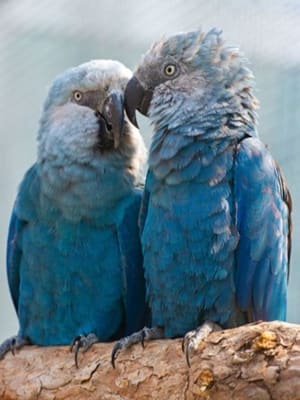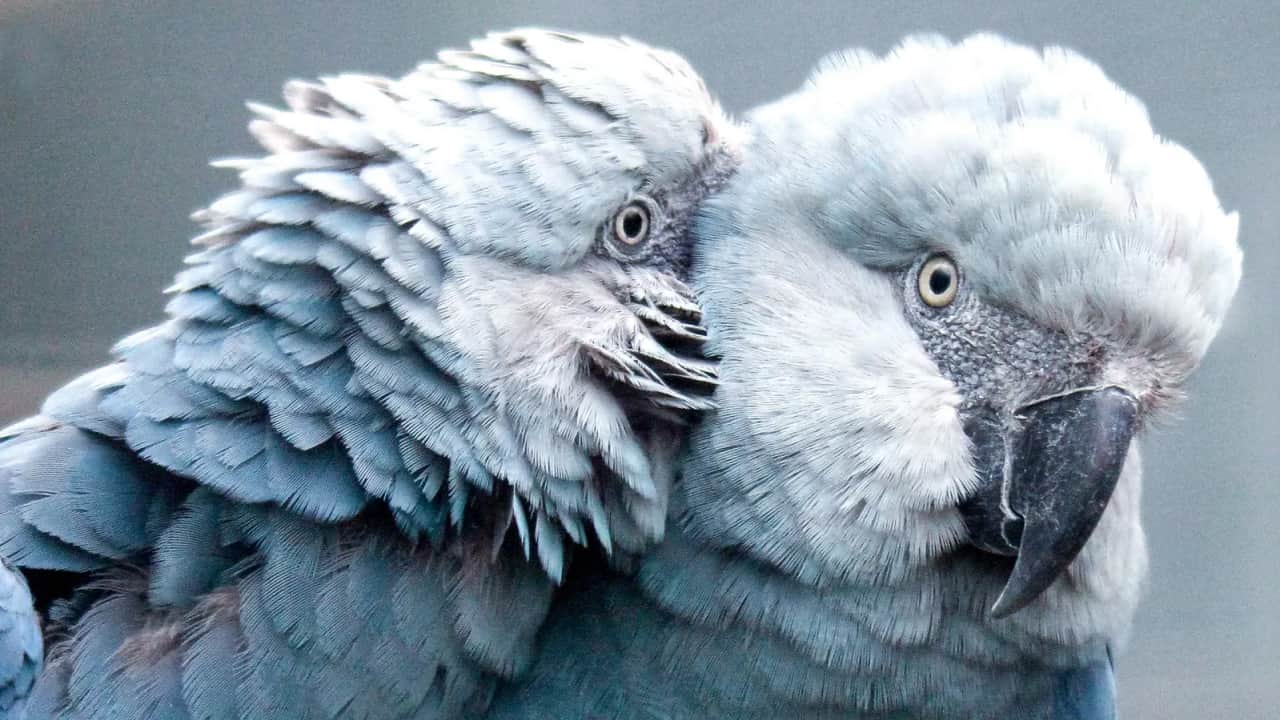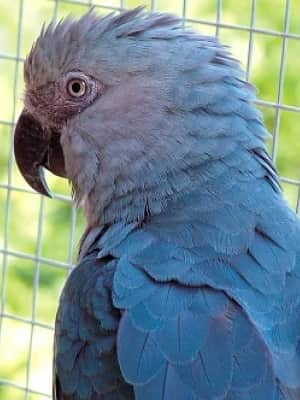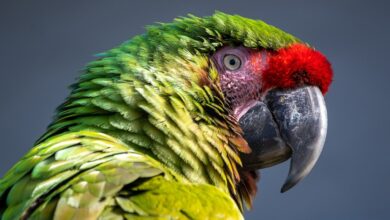Spix’s Macaw – Facts, Diet & Habitat
Spix Macaw is one of the limited and unique birds in the world which is also known as little blue Macaw. They were first discovered and then reported in the 19th century. But even after 200 years there are only a few observations that have been done on these species.
Table of Contents
These Birds are considered as the most endangered species of birds in the world and in 2000 they were declared as extinct due to illegal trading. In black market they were bought for millions of dollars which also became the main reason for its extinction.
A Rare Gem of the Avian World
| Attribute | Details |
| Scientific Name | Cyanopsitta spixii |
| Common Name | Spix’s Macaw, Little Blue Macaw |
| Tribe | Arini |
| Family | Psittacidae |
| Species | Cyanopsitta |
| Length | 55-57 cm (21-22 inches) |
| Region | Northeastern Brazil, Rio Sao Francisco valley |
| Diet | Seeds, Nuts, and Fruits |
| Year of Extinction | In 2000 |
| Conservation Status | Critically Endangered |
| Weight | 300 grams (11 oz) |
Spix’s parrot is located in the region of northeastern Brazil, especially in the Rio Sao Francisco valley. This valley contains rivers, forests and streams which enhance its natural beauty. These macaws are known for their vibrant blue color and lighter part on their head and grey on the underpart. Right now, only 79 Spix’s Macaws exist in the world. These birds are the rare gem of the Avian world.
Is Spix Macaw Near Extinction?

It was noted that people have hunted them for fun but only hunting was not the cause of decrease in the amount of these birds. There are also other factors which became the main cause of the extinction of Blue Macaws.
These factors include illegal trapping for bird trade because even at that time Spix Macaw collectors paid thousands of dollars for a single bird. And even now, these species are worth five times the amount of money which was in the past and it makes it difficult for the extinct Blue Parrot protectors to protect them.
Habitat destruction is also another major factor for extinction because of the destruction of forests, especially the caraibeira trees which are essential for their survival.
Additionally, the Africanized Bees took over their nesting sites which made it even more difficult for them to reproduce in the wild. These factors led them to be declared as extinct in 2000 when the last known survival disappeared from site. The IUCN declared this species as extinct.
Then in 2022, Blue Macaw was successfully reintroduced in the wild. After decades of being considered extinct, a carefully planned program brought them back into their natural habitat in Brazil. This program included releasing 8 Macaws back into the Wildlife Refuge.
They were also trained to protect themselves from predators and they also put trackers on them to monitor their movements and ensure their safety. Conservationists planted native plants especially caraibeira trees to give them a natural environment. The purpose of this program is also to give hope for the endangered species.
Behavioral Adaptation

Brazilian Blue Macaw are intelligent birds and also observed as social because most of the time they are present in pairs or small groups. They usually travel in the form of pairs or small groups, hunting for the food. The food Macaws eat consists of seeds, fruits, and nuts found in their natural habitat especially from caraibeira tree which plays main role in their survival.
Spix also eat clay in addition to their diet because it may help them to digest. Their strong, curved beak helps them to break tough nuts and seeds. These birds are famous for their nature of being curious and playful, making them mesmerize to observe in the wild. They are also known by another name “talking birds” because they mimic human voices and different sounds.
Related Pick: 18 Different Species of Macaws in The World
These birds depend upon the mature trees along the streams to make their nests. They use specific voices like whistles, squawks, and honks to communicate and locate their mates and to identify each other. They reach their sexual maturity at the age of 7. And females can lay usually 2 or 3 eggs at a time.
International Fame

Spix Macaw gained international popularity from an Animated movie Rio (2011). This movie tells the story of two Blue Macaws, one male and the other female who started their journey to find others of their kind.
The movie Rio gained international fame which made people aware of the challenges faced by the endangered parrots.
The story of Rio is fictional but based on a true life story. Because the last known bird living in the wild disappeared and tragically after years of disappearing, an avian veterinarian contacted to examine a blue bird named Presley but recognized it as Spix’s.
After that the number of Spix’s has been steadily increasing. The majority of birds now belong to the privately owned facility in Qatar. This movie’s other purpose is to inspire global conservation efforts.
Conservation Efforts

In order to save the endangered species several conservation efforts have been done and several have been launched. As the story of Spix Macaw shows the symbol of hope, resilience and collaboration. The journey from extinction to reintroduction highlighted the importance of collaboration and conservation efforts. To save the endangered species several conservation programs have been launched:
Captive Breeding Programs
Organizations like the Association for the Conservation of Threatened Parrots (ACTP) and Brazilian conservation groups have worked vigorously to reproduce Spix’s Parrots under their control. These programs have become successful to increase the population, with over 250 individuals now living peacefully in the protected environment.
Reintroduction Projects
In 2020 an innovative effort saw to release the Spix Macaw back into the natural habitat in Bahia, Brazil. This historic reintroduction was arranged by the community engagement and the habitat restoration to ensure the birds survival and lower the number of endangered species.
Public Awareness Campaigns
Social media and gathering have a great impact on the living individuals as the movie creates awareness about the endangered parrots. So documentaries, social media camping and educational programs have been arranged to increase the awareness about the plight of Spix’s Macaw, inspiring support for conservation efforts.
Magical Blue Macaw – Incredible Bright Indigo Feathers
You must have heard about and probably seen a blue Macaw, either in the zoo or on TV or read about them in magazines. Here are some of the biggest color species of the parrot family. Dressed in bright blue features, they really look very attractive.
Habitat Restoration
Habitat restoration was also very necessary for Spix Macaw to live peacefully in their natural habitat so efforts are ongoing to replant the native tree like caraibeira and also the native forest for their survival.
Conclusion
The Spix Macaw is the symbol of hope and the power to conserve species. Its journey from near extinction to reintroduction highlights the importance of protecting biodiversity and the impact that collective action makes.
While challenges remain, the effort to save this enchanting species serves as a testimony of human abilities to make big differences. By supporting conservation initiatives and raising awareness, we can ensure that the Little Blue Macaw continues to develop for generations to come.
